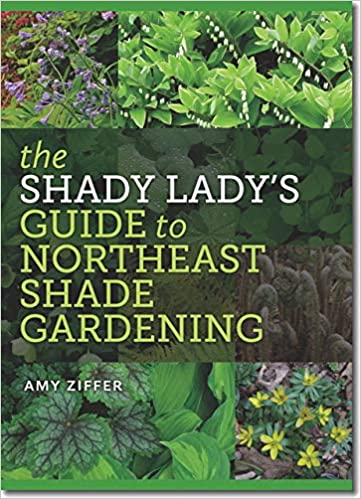The Shady Lady’s Guide to Northeast Shade Gardening by Amy Ziffer
How would you feel if you were the person responsible for kudzu?
Assuming for a second that the blame for the Vine that Ate the South could be pinned on just one person, and you were that person, would you feel guilty? Defensive? Or would you just not care?
Or how about the Shakespeare lovers who released starlings in the New World just because the bird is mentioned in Henry IV? Or the gentleman farmer who let loose rabbits in Australia for “a spot of hunting,” also asserting “the introduction of a few rabbits could do little harm.”
Two hundred million starlings, 7 million kudzu-engulfed acres, and inestimable numbers of rabbits later, we shake our heads at these follies and wonder, “didn’t anyone think that that vine/those birds/a few rabbits might get out of hand?”
And yet, I can’t tell you how many times I’ve had people come up to me and tell me how happy they were to discover that Plant X—and here you can fill in any number of things from goutweed (Aethionema podograria ‘Variegata’) to roadside orange daylily (Hemerocallis fulva) to crown vetch (Securigera varia)—“spreads.”
What these folks fail to anticipate is that spreading plants do not recognize either garden boundaries or property lines (or, for that matter, such fine legal distinctions as state or national borders). People imagine that spreading plants will grow to fill only the desired area and then, magically, stop. This will not happen. What will happen is more along the lines of this episode from the cult classic TV series The Avengers: Man-Eater of Surrey Green.
Don’t be disarmed by the humor. Although I have yet to encounter a carnivorous spreading plant, all of them are, in a sense, herbivorous: they eliminate neighboring plants by displacing them. The species they will displace include your other garden plants, the native vegetation, and any wildlife dependent on the doomed greenery. Where one spreading plant encounters another, they duke it out in a fight to the death or a sulky stalemate. To put it succinctly, the meek do not inherit any patch of Earth where bamboo has been planted.
Now, I have to qualify this. First, the “spreading” nature of spreading plants is not inherently the problem. All plants spread to one degree or another if conditions permit. However, some are far more aggressive than others. But even an aggressive spreader can be perfectly appropriate in its native environment. The problem is an aggressively spreading plant where it doesn’t belong—basically, the non-natives.
Second, don’t bother writing to tell me I have it all wrong, that I don’t understand that there are clumping and running bamboos, or any other variant on “you don’t know what you’re talking about.” I have spent 16 years cleaning up the vegetative messes other people have made on properties, messes that at least some of them undoubtedly made with the best of intentions to control the spreading plants they installed.
The reality is that when life calls, things that are perceived as “non-essential” go undone. And unfortunately, getting out the spade to cut away the hundreds of linear feet of unwanted whatever around the perimeter of that planting that started out oh-so-small many, many years ago is always on the “non-essential” list.
Even if you are a member of that small percentage of the gardening population who will actually make good on your intentions to keep a spreading plant in bounds, the next person who owns your property almost certainly won’t. Few will even know what it is.
I know that at this point some readers will think I’ve descended into preaching. I’m not even going to argue that point. I’ll just observe that any advice, good or bad, can be labeled “preaching” when it contains a message unpopular to some ears.
The only thing I’m really asking you to do is pay attention to the lesson of the kudzu, the starlings, and the rabbits. They are not fanciful, imaginary environmental degradation scenarios. They are real-life examples of the workings of the law of unintended consequences.
Mistakes don’t have to have continental scope to be mistakes. A problem whose extent is limited to one property or one neighborhood is still a problem. I am only asking you to consider whether giving space to some non-native spreading plant that seems like a short-term problem solver isn’t actually the first step in creating a problem that will leave some future owner of your home shaking her head in wonderment at how you couldn’t have foreseen that that plant would get out of control.
Recently, I was in the checkout line at a local store when I encountered a gardener acquaintance who began enthusiastically telling me about a new addition to her garden. I won’t even name the plant. Thinking that perhaps she didn’t know about its invasive tendencies, I asked her if she knew it would spread and probably become an unmanageable problem.
Her reply? “I don’t care,” she said. “I know it will spread, and that’s okay. I like the way it looks.”
So what I’m really asking is this: please care. Before you plant, please care about what you’re doing.

 AMY ZIFFER is the owner of A Shady Lady Garden Design and a former editor at Fine Gardening. She has written for Yankee, Horticulture, and many other gardening, lifestyle, and consumer publications. Her latest book, The Shady Lady’s Guide to Northeast Shade Gardening is out from University Press of New England May 6.
AMY ZIFFER is the owner of A Shady Lady Garden Design and a former editor at Fine Gardening. She has written for Yankee, Horticulture, and many other gardening, lifestyle, and consumer publications. Her latest book, The Shady Lady’s Guide to Northeast Shade Gardening is out from University Press of New England May 6.
Image Credits:
Cover Photo: http://www.kuriositas.com/2013/07/the-day-of-kudzu.html
Author Photo: Ken Stabile
Buy this Book!
Amazon




